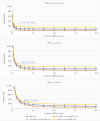Cost-effectiveness of Routine Provider-Initiated Testing and Counseling for Children With Undiagnosed HIV in South Africa
- PMID: 35028333
- PMCID: PMC8753042
- DOI: 10.1093/ofid/ofab603
Cost-effectiveness of Routine Provider-Initiated Testing and Counseling for Children With Undiagnosed HIV in South Africa
Abstract
Background: We compared the cost-effectiveness of pediatric provider-initiated HIV testing and counseling (PITC) vs no PITC in a range of clinical care settings in South Africa.
Methods: We used the Cost-Effectiveness of Preventing AIDS Complications Pediatric model to simulate a cohort of children, aged 2-10 years, presenting for care in 4 settings (outpatient, malnutrition, inpatient, tuberculosis clinic) with varying prevalence of undiagnosed HIV (1.0%, 15.0%, 17.5%, 50.0%, respectively). We compared "PITC" (routine testing offered to all patients; 97% acceptance and 71% linkage to care after HIV diagnosis) with no PITC. Model outcomes included life expectancy, lifetime costs, and incremental cost-effectiveness ratios (ICERs) from the health care system perspective and the proportion of children with HIV (CWH) diagnosed, on antiretroviral therapy (ART), and virally suppressed. We assumed a threshold of $3200/year of life saved (YLS) to determine cost-effectiveness. Sensitivity analyses varied the age distribution of children seeking care and costs for PITC, HIV care, and ART.
Results: PITC improved the proportion of CWH diagnosed (45.2% to 83.2%), on ART (40.8% to 80.4%), and virally suppressed (32.6% to 63.7%) at 1 year in all settings. PITC increased life expectancy by 0.1-0.7 years for children seeking care (including those with and without HIV). In all settings, the ICER of PITC vs no PITC was very similar, ranging from $710 to $1240/YLS. PITC remained cost-effective unless undiagnosed HIV prevalence was <0.2%.
Conclusions: Routine testing improves HIV clinical outcomes and is cost-effective in South Africa if the prevalence of undiagnosed HIV among children exceeds 0.2%. These findings support current recommendations for PITC in outpatient, inpatient, tuberculosis, and malnutrition clinical settings.
Keywords: HIV; PITC; cost-effectiveness; pediatric.
© The Author(s) 2021. Published by Oxford University Press on behalf of Infectious Diseases Society of America.
Figures




References
-
- UNAIDS. UNAIDS data 2020. 2020. Available at: https://www.unaids.org/sites/default/files/media_asset/2020_aids-data-bo.... Accessed 8 October 2020.
-
- UNAIDS. Children and HIV: fact sheet. 2016. Available at: https://www.unaids.org/sites/default/files/media_asset/FactSheet_Childre.... Accessed 31 July 2019.
-
- World Health Organization. Consolidated Guidelines on the Use of Antiretroviral Drugs for Treating and Preventing HIV Infection: Recommendations for a Public Health Approach. World Health Organization; 2013. Available at: http://www.who.int/hiv/pub/guidelines/arv2013/download/en/index.html. Accessed 20 October 2019. - PubMed
-
- World Health Organization. Male Involvement in the Prevention of Mother-to-Child Transmission of HIV. World Health Organization; 2012. Available at: https://apps.who.int/iris/bitstream/handle/10665/70917/?sequence=3. Accessed 21 February 2021.

